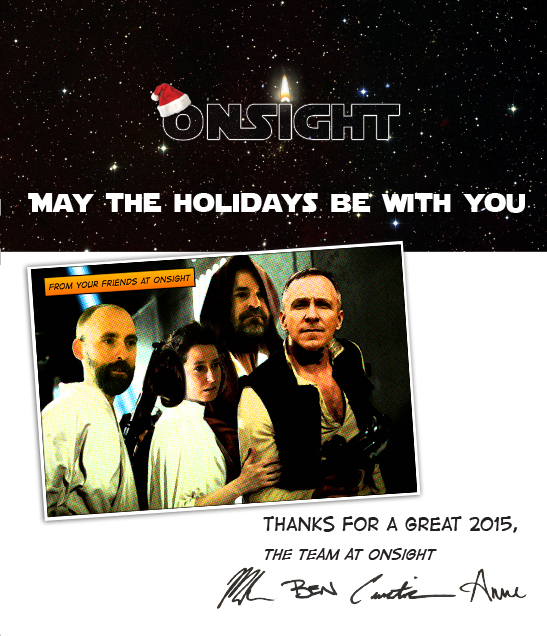
by OnSight | Jan 2016 | Social Media, Web Communications
Whether you’re launching a new project or just making sure your organization is keeping up with the changing times, you need to have a web site — you might as well make sure it’s doing its job well. As the internet and mobile systems evolve, it can be challenging to stay on top of best practices. Below are the seven most important features of a good web site — some are small tweaks that can likely be done within your existing web management tool; others may require a more intense overhaul.
1. Mobile compatibility
Almost one-third of all web content is now viewed on mobile devices like cell phones and tablets, and over half of the time spent online is via mobile devices…and those numbers are only expected to rise. If you haven’t already, it’s a crucial time to ask the basic question: Does your web site work on mobile? Can visitors access the menus, read the type, and see the content clearly? Are pages lightweight enough that images load quickly and web elements resize dynamically? On a more foundational level, make sure to go through and streamline content with an eye towards small screens — web visitors don’t have the patience or screen capacity for long, dense blocks of text, so avoid those wherever possible.
2. Social sharing
With tools like Facebook, Twitter, Instagram, Tumblr, Pinterest and other social networks (including email!) claiming more and more of our daily screen time, it’s vital that your fans can share your content easily and that your content is designed to post cleanly to social media sites. Social networking sites are a large and growing percentage of traffic to web sites — make it easy for fans of your work to tell their friends about you!
3. Good content
As with anything else, the key to a good outcome is having a good product. If the content on your web site is boring, wonky and overly technical, confusing, or outdated, visitors will simply look elsewhere. To make sure users stay on your site when they find it, and keep coming back for more in the future, the content itself must be current, interesting, well-written, and compelling. There is simply no substitute for good content.

This is a bad web site.
4. Good design
First impressions matter. Putting your carefully crafted content into a format that reflects the professionalism, playful spirit, inspiring vision, or dependability of your organization is a key component of how you will be perceived. Visitors will quickly discount information in a format that makes it look dated or untrustworthy — even if the information itself is current and relevant to their interests — and they won’t waste their time on a site that makes it difficult to read or access the information they’re looking for.
5. Clean structure
So you’ve punched up your copy to make it compelling and easy to understand and invested in clean, contemporary design…but can site visitors find what they’re looking for? All web design should be founded upon a simple and inviting user experience, enabling visitors to easily locate information and engage with your organization. Consistency and usability are the guiding principles for any design process. Overly-complicated menus, conflicting or absent hierarchies, and lack of underlying structure will show through when visitors actually engage with your site. Frustrating someone who wants to join your cause or contribute to your campaign is bad business.
6. SEO
Search Engine Optimization — don’t let the acronym scare you away from what is a critically important feature of any successful web site. Google (and other search engines) account for anywhere from a 1/4 to 2/3 of traffic to most web sites, and over 90% of clicks are on the first page of Google search results. So how to make sure your web site is showing up on that first page of links? You web site might host exactly the product, service, or opportunity someone is looking for…but if you aren’t using SEO best practices, how will anyone be able to find you?
7. Analytics
How are people finding out about your site? Which pages are they spending the most time on? What is the most frequently visited page? Understanding what your site’s visitors actually do — which is definitely not always what you’d expect them to do — is an important part of the web development process. A good web site is one that is constantly being refined to take advantage of insights gleaned from web analytics and testing. Everything from making sure you’re using the most effective color for a donate button to optimizing the amount of text on an informational page can be tweaked, tested, analyzed, and tweaked again to make your web presence more effective for your organization and more helpful to your fans.

by OnSight | Dec 2015 | OnSight News


by OnSight | Dec 2015 | Google
 Denverites in 2015 were interested in the hometown NFL team’s schedule, a hurricane, a movie about dinosaurs and the fate of NBA star Lamar Odom, according to data compiled by Google and releases as part of its Year in Search earlier this week.
Denverites in 2015 were interested in the hometown NFL team’s schedule, a hurricane, a movie about dinosaurs and the fate of NBA star Lamar Odom, according to data compiled by Google and releases as part of its Year in Search earlier this week.
We’re interested in Google, of course, as the firm that helps them with PR and press in Colorado.
Google’s localized search results found a good audience in the Denver-metro area, as the story was picked up by The Denver Post, The Denver Business Journal, 9News, Fox31 The Denver Channel (KMGH7) and KOA radio, among others.
Below are the Top Trending Searches, News/Events, People and Films that Denver wanted to know more about in 2015.
Top-trending Denver searches 2015:
- lamar odom
- broncos schedule 2015
- bobbi kristina brown
- jurassic world
- ronda rousey
- american sniper
- hurricane patricia
- super bowl 2015
- straight outta compton
- caitlyn jenner
Top-trending Denver news/events 2015:
- hurricane patricia
- paris
- nfl playoffs
- oregon shooting
- lunar eclipse
- blood moon
- mayweather vs pacquiao
- democratic debate
- charlie hebdo
- republican debate
Top-trending Denver people searches 2015:
- lamar odom
- bobbi kristina brown
- ronda rousey
- caitlyn jenner
- ruby rose
- stuart scott
- chris kyle
- donald trump
- sandra bland
- brian williams
Top-trending Denver film searches 2015:
- jurassic world
- american sniper
- straight outta compton
- 50 shades of grey
- the visit
- pitch perfect 2
- the martian
- minions
- inside out
- avengers age of ultron
Year in Search is meant to reflect “the spirit of the times”, and Google strives to capture this spirit through exploring the year’s new and exciting search terms. Trending searches are queries that have had the highest spike in traffic over a sustained period in 2015 as compared to 2014.
Google studied an aggregation of trillions of searches (or queries) that people asked Google Search this year. Data was used from multiple sources, including our public tool, Google Trends and internal data tools. Spam and repeat queries were filtered out to build lists that best reflect the spirit of 2015.
For more information as well as a video covering a global tour through 2015, visit the 2015 Year in Search website.

by OnSight | Dec 2015 | Elections, Graphics
99% Invisible is a really fantastic podcast that focuses on design of all kinds — from the built-in sound effects on your mobile device to urban planning, almost everything gets designed at some point in its development. And those times when it doesn’t — when a lack of intentional design is the story — well, 99PI covers those examples, too.

Ballots are an essential component to a working democracy, yet they are rarely created (or even reviewed) by design professionals. (Text from 99% Invisible, photo via Wikimedia)
Last week, 99PI did a great piece on ballots, and this one definitely falls into the latter camp. Because of the history of election management in the US (a history the podcast briefly delves into), what we see when we go to cast our vote varies enormously from county to county across the country…and is almost always developed by someone who doesn’t have the tools to think about good design.
And this can have serious implications! From ballots printed in 6-point type ALL-CAPS typefaces to the infamous “butterfly ballot” that arguably changed the course of the 2000 presidential election, 99% Invisible makes the case that good design is ignored at our peril…in elections as in everything else our society takes on.

by OnSight | Nov 2015 | Social Media

Every social media network ever (subject to change without notice). Via Wikimedia.
Facebook, Twitter, Pinterest, Tumblr, YouTube, Instagram, Snapchat, LinkedIn, Google+, Vine…the list goes on, and more are added every day. Social media platforms give organizations and campaigns an unprecedented ability to engage directly with the people you’re trying to reach, provide your audience a chance to connect directly with you, and allow your fans to help spread your message directly to their networks. An effective social media presence is not just a simple matter of logging in once in a blue moon and sharing a couple of posts from other outlets. To make it work, you need to be investing thoughtfully in the following practices:
1. Prioritize
Don’t try to be everywhere at once! Unless you have a bottomless well of staff time and creativity to draw from, you need to prioritize. Better to be on just a couple of networks and doing it well than to be spreading yourself too thin trying to be everywhere at once. And where your you should focus is going to vary quite a bit from organization to organization — if you have access to a source of rich visuals, it’s probably going to be Instagram or Pinterest; if you have a clever staffer who can be given some free reign, they might want to be on Instagram; if you are trying to educate about a complicated topic, perhaps a Reddit AMA might be worth exploring. There are dozens of social media networks appealing to all sorts of audiences, from broad to more niche and specialty. Define your audience and the style of interaction that will suit you best and focus your efforts there.
2. Produce Good Content
Constant information bombardment, access, and overload are an inescapable feature of today’s wired world. To have any chance of breaking through the noise requires content that the audience decides is worth engaging with. It must be thoughtful, emotionally rich, self-referential (i.e., relevant to THEM, the audience, not YOU, the content publisher), funny, timely, interesting, shocking, and/or make people feel like part of a movement.
3. Be Consistent
Social media campaigns are too often treated as an afterthought, something that can be done on a catch-as-catch-can basis. To be effective, however, a social media campaign needs to have strategic vision, a sense of consistency of voice, and a sense of consistency with timing – the audience needs to know what to expect from the campaign, and the more that expectation is of good, timely content, the more interaction with the campaign will result.
4. Interact
The social web is not a one-way street, a simple one-to-many form of communication; it needs to be treated as truly interactive. An effective campaign cannot simply publish a stream of good content and walk away – there needs to be a sense of true interaction with the audience – answering questions, responding with genuine care, having a distinct voice/personality…in other words, there needs to be a really person at work, not merely a ghost in the machine.
5. Engage
A strategy that engages your audience – one that makes them feel like they are doing something – is key to bringing new supporters on board. A good social media campaign should regularly integrate asks of all shapes an sizes – polls, posts, questions, surveys, petitions, events, etc.
6. Be willing to pay
The social landscape – especially with respect to Facebook’s algorithms (e.g., how it is Facebook decides what to display in a user’s feed) – is shifting rapidly, but one thing is clear: Facebook (the largest and most trafficked social network to date) is more and more moving to a “pay to play” policy. Page managers can not expect content – even good content – to make it into users’ news feeds without ongoing investment in Facebook’s ad ecosystem. The good news is, the ads are relatively inexpensive, highly targetable, and generally quite effective. Other social networks – notably Twitter and Instagram – are making ads more affordable and integrated into users’ feeds, as well.
7. Analyze and iterate
Understanding what is – and isn’t – working for any audience is a key to a successfully executed social media campaign. Regular analysis of posts, progress toward goals, and high and low performing actions needs to be undertaken to refine the plan and inform the tactics of the campaign on a regular basis.
Need help lighting a fire under your social media presence? Contact OnSight today to talk about how we can help you develop a social media roadmap for your organization, campaign, and business.









